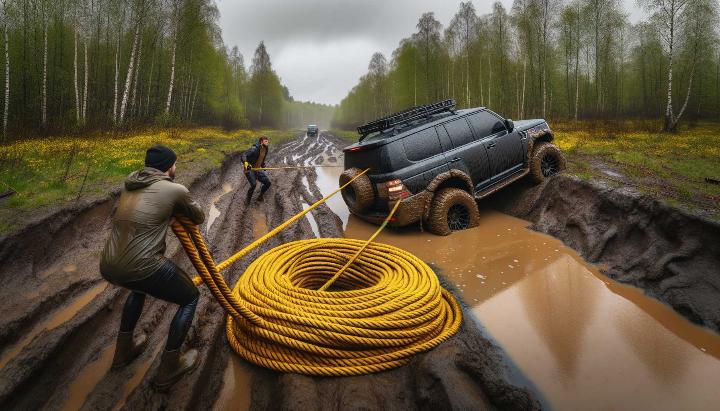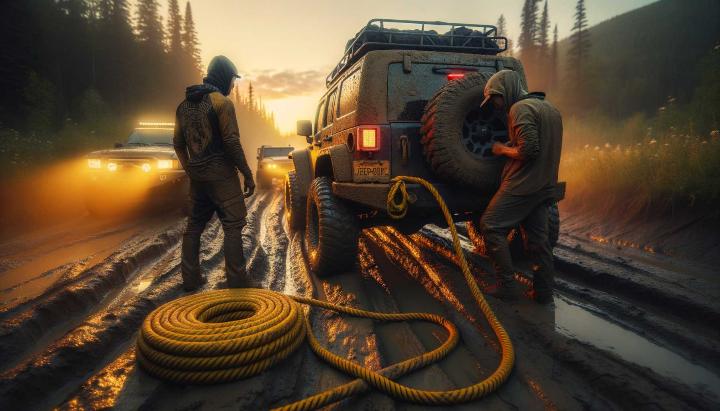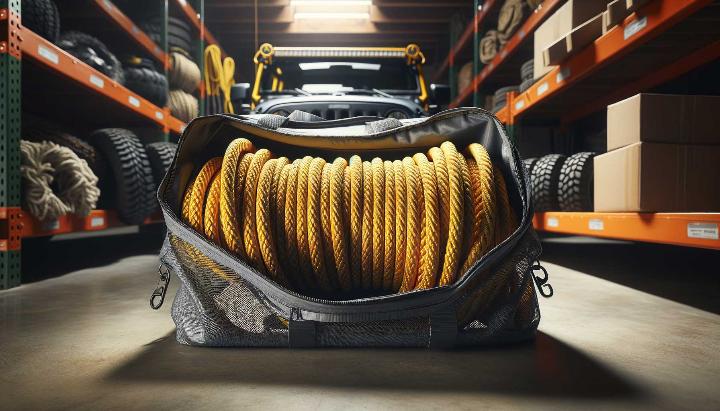Ever found yourself bogged down in the middle of nowhere, your 4x4 spinning its wheels helplessly in mud or sand? Enter the unsung hero of off-road adventures: the kinetic recovery rope. This isn't your average tow rope; it's a high-tech lifeline designed to pull you out of the stickiest situations with surprising ease and safety.
Crafted from nylon 66, the material of choice for its superior elongation properties, a kinetic recovery rope is your ticket to freedom when the terrain decides to keep your vehicle hostage. But why should you care about this particular piece of kit?
In this comprehensive guide, we'll unravel the mysteries of vehicle recovery ropes, explore the game-changing benefits of recovery rope 4x4 systems, and dive deep into the world of ASR recovery ropes. Whether you're a seasoned off-roader or just dipping your toes into the muddy waters of adventure, understanding these powerful tools could be the difference between a minor setback and a major headache on your next expedition.
Buckle up as we embark on a journey through the science, selection, and proper use of kinetic recovery ropes. By the end, you'll be equipped with the knowledge to choose the right rope, use it safely, and maintain it for years of reliable service. Let's get unstuck and back on track!
Understanding Kinetic Recovery Ropes: What They Are and How They Work
Have you ever found yourself stuck in a muddy rut or a sandy ditch during an off-road adventure? If so, you'll appreciate the power of a kinetic recovery rope. These innovative tools have revolutionised vehicle recovery, making the process smoother, safer, and more efficient than ever before.
The Science Behind Kinetic Energy in Vehicle Recovery
Kinetic recovery ropes, also known as snatch ropes or yanker ropes, are designed to harness the power of kinetic energy during vehicle recovery operations. Unlike traditional static tow ropes or cables, these dynamic marvels stretch and contract, absorbing and transferring energy in a way that can feel almost magical when you see it in action.

Here's how it works: When a recovery vehicle begins to pull a stuck vehicle, the kinetic rope stretches, storing energy like a giant rubber band. As it reaches its maximum stretch, it begins to contract, transferring that stored energy to the stuck vehicle. This creates a smooth, powerful pull that's less jarring than a sudden yank from a static rope.
Key Features and Benefits of Kinetic Recovery Ropes
- Reduced shock load: The stretching action of the rope significantly reduces the shock on both vehicles, making the recovery process safer and less likely to cause damage.
- Increased pulling power: By harnessing kinetic energy, these ropes can provide up to 30% more pulling power compared to static ropes.
- Versatility: Kinetic ropes are suitable for a wide range of vehicles and recovery situations, from small 4x4s to larger trucks.
- Durability: Made from high-strength materials like nylon, these ropes are built to withstand repeated use in challenging conditions.
When choosing a kinetic recovery rope, remember that size matters. The general rule of thumb is to select a rope with a strength rating 2-3 times your vehicle's Gross Vehicle Mass (GVM). This ensures you have ample pulling power while maintaining a safety margin. Explore more about why Kinetic Recovery Ropes are a crucial investment for off-road safety.
Pro Tip: Always inspect your kinetic recovery rope before each use. Look for signs of wear, fraying, or damage, and replace the rope if you spot any issues. Your safety depends on it!
Next time you're planning an off-road adventure, make sure a quality kinetic recovery rope is part of your essential gear. It could be the difference between a minor setback and a major headache when the going gets tough. Stay safe out there, and happy trails!
Choosing the Right Vehicle Recovery Rope
When you're knee-deep in mud or axle-deep in sand, the last thing you want is a subpar recovery rope. Let's dive into the nitty-gritty of selecting the perfect vehicle recovery rope for your off-road adventures.
Understanding Kinetic Recovery Rope Strength
The cornerstone of any reliable recovery rope is its breaking strength. But what exactly does that mean for you and your 4x4? Simply put, it's the maximum load your rope can handle before it snaps. Here's the golden rule: choose a rope with a breaking strength 2-3 times your vehicle's weight.
For instance, if your rugged beast weighs 2,500 kg, you'll want a rope with a breaking strength between 5,000 kg and 7,500 kg. This ensures you've got ample pulling power with a safety buffer to boot.
Pro Tip: Always check your vehicle's Gross Vehicle Mass (GVM) when selecting a recovery rope. This includes the weight of passengers, cargo, and any modifications you've made to your rig. To find a suitable product, consider browsing our Kinetic Recovery Ropes collection.
Factors to Consider When Selecting a Recovery Rope
Choosing the right recovery rope isn't just about strength. Here are some key factors to keep in mind:
- Rope length: Typically, a 9-metre rope works well for most situations. It provides enough distance between vehicles for safety while maintaining efficient energy transfer.
- Terrain considerations: If you frequently tackle steep inclines or deep mud, you might want to opt for a longer rope to provide more flexibility in recovery positions.
- Material and durability: High-quality nylon is the go-to material for kinetic recovery ropes. It offers excellent stretch and durability, crucial for absorbing shock during recovery.
- Rope diameter: This often correlates with breaking strength. Thicker ropes generally offer higher breaking strengths but can be heavier and more challenging to handle.
Remember, your recovery rope is a lifeline in sticky situations. Don't skimp on quality - invest in a rope that'll have your back when the going gets tough.

When it comes to off-road recovery, your rope choice can make or break your adventure. By considering factors like breaking strength, rope length, and material, you'll be well-equipped to tackle whatever challenges the trail throws your way. Stay safe, choose wisely, and happy trailing!
Proper Use and Safety Precautions
When it comes to vehicle recovery, safety should always be your top priority. Let's dive into the essential precautions and proper techniques for using a kinetic recovery rope effectively and safely.
Step-by-Step Guide: Using a Kinetic Recovery Rope Safely
- Assess the situation: Before attempting recovery, evaluate the stuck vehicle's position and surrounding terrain.
- Clear the area: Ensure bystanders are at a safe distance, at least 1.5 times the length of the rope.
- Inspect your equipment: Check both vehicles' recovery points and the kinetic rope for any damage.
- Connect the rope: Attach the rope to both vehicles' designated recovery points using proper shackles.
- Communicate clearly: Establish clear hand signals or radio communication between drivers.
- Tension the rope: The recovery vehicle should slowly move forward until the rope is taut.
- Execute the recovery: Accelerate smoothly to stretch the rope, then maintain steady power.
- Disconnect safely: Once the stuck vehicle is free, carefully remove the rope and stow it properly.

Important Safety Considerations
- Personal protective equipment (PPE): Always wear gloves and eye protection during recovery operations.
- Vehicle compatibility: Ensure the recovery vehicle is of equal or greater weight than the stuck vehicle.
- Rope condition: Regularly inspect your rope for signs of wear, UV damage, or fraying.
- Recovery points: Only use manufacturer-approved recovery points on both vehicles.
- Load rating: Never exceed the working load limit of your rope or recovery gear.
Common Mistakes to Avoid
Even experienced off-roaders can make mistakes. Here are some pitfalls to watch out for:
- Using damaged equipment: Never attempt a recovery with frayed ropes or worn shackles.
- Incorrect attachment: Avoid attaching the rope to non-designated points like tow balls or tie-down hooks.
- Spectator danger: Keep onlookers well away from the recovery zone to prevent injuries from potential rope recoil.
- Sudden movements: Jerking or abrupt accelerations can cause equipment failure and increase risks.
- Overconfidence: Don't hesitate to reassess the situation if the initial recovery attempt fails.
Remember: A successful recovery isn't just about getting unstuck—it's about doing so safely. If you're unsure about any aspect of the recovery process, it's always better to seek professional help. You might consider consulting detailed guides, such as our Essential Recovery Rope Guide, for more in-depth advice.
By following these guidelines and prioritising safety, you'll be well-equipped to handle vehicle recovery situations confidently and responsibly. Have you ever used a kinetic recovery rope in a tricky situation? Share your experience in the comments below!
Maintenance and Storage of ASR Recovery Rope
Your ASR recovery rope is more than just a piece of equipment—it's your lifeline in sticky situations. Proper care and storage are crucial to ensure it's ready when you need it most. Let's dive into some practical tips to keep your kinetic recovery rope in top shape for your next off-road adventure.
Cleaning Your ASR Kinetic Recovery Rope
After a muddy recovery operation, your rope might look like it's been through the wringer. Here's how to give it some TLC:
- Rinse thoroughly: Start by rinsing off excess mud and debris with clean water.
- Prepare a cleaning solution: Mix warm water with a mild, pH-neutral detergent.
- Gentle scrubbing: Using a soft-bristled brush, work the solution into the rope fibres.
- Rinse again: Thoroughly rinse the rope with clean water to remove all soap residue.
- Air-dry completely: Hang the rope in a well-ventilated area, away from direct sunlight.
Pro Tip: Never use harsh chemicals or high-pressure washers on your ASR recovery rope. These can damage the synthetic fibres and compromise the rope's integrity.
Proper Storage Techniques for Recovery Gear
Proper storage is key to maintaining your ASR recovery rope's performance and longevity. Here's how to do it right:
- Cool, dry place: Store your rope in a cool, dry area away from direct sunlight and extreme temperatures.
- Coil it correctly: Use the over-under coiling method to prevent twists and kinks in the rope.
- Avoid contact with chemicals: Keep your rope away from petroleum products, acids, and other harsh substances.
- Use a storage bag: Consider investing in a breathable storage bag to protect your rope from dust and debris.

Remember, a well-maintained ASR recovery rope can stretch up to 30% of its length, providing that crucial kinetic energy for smooth vehicle recoveries. Regular inspections are vital—look out for signs of wear such as fraying, discolouration, or flat spots.
When should you replace your rope? If you notice any significant damage or if the rope has been subjected to a severe shock load, it's time for a new one. Generally, with proper care, a quality ASR recovery rope can last for several years of regular use.
By following these maintenance and storage tips, you'll ensure your ASR recovery rope remains a reliable partner in your off-road adventures. Have you got any personal rope care routines that have served you well? Share them in the comments below—your fellow 4x4 enthusiasts would love to hear them!
Kinetic recovery ropes are an essential tool for effective vehicle recovery, particularly for off-road enthusiasts who venture into challenging terrains. Unlike traditional ropes or cables, a kinetic recovery rope—often made of durable nylon 66—utilises stretching to smoothly extract a stuck vehicle from mud, sand, or ditches. By absorbing and releasing kinetic energy, this type of recovery rope 4x4 can offer up to 30% more pulling power, significantly reducing the shock on both vehicles. When choosing an ASR recovery rope, consider factors such as vehicle weight and rope length, ensuring safety and reliability in your adventures. Regular maintenance is crucial for longevity, including careful storage and frequent inspections for wear and tear.
Discover the Power of Kinetic Recovery Ropes
Fill in the form above to learn more about selecting the ideal kinetic recovery rope for your needs. Secure the right gear to make your off-road experiences safer and more enjoyable, ensuring you're prepared for any recovery situation.